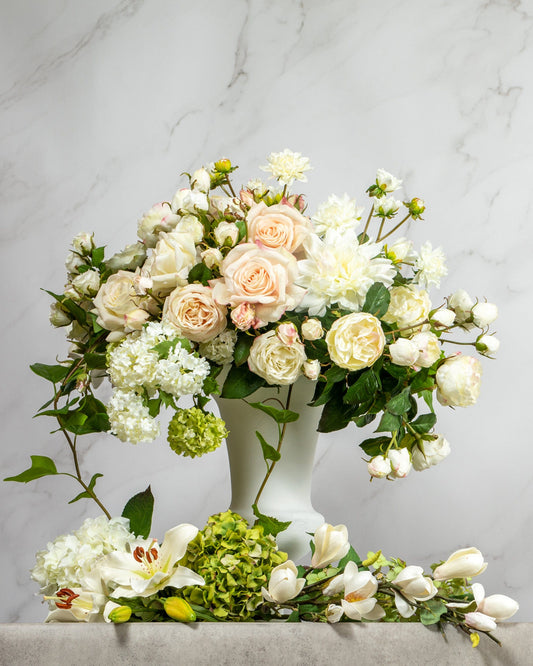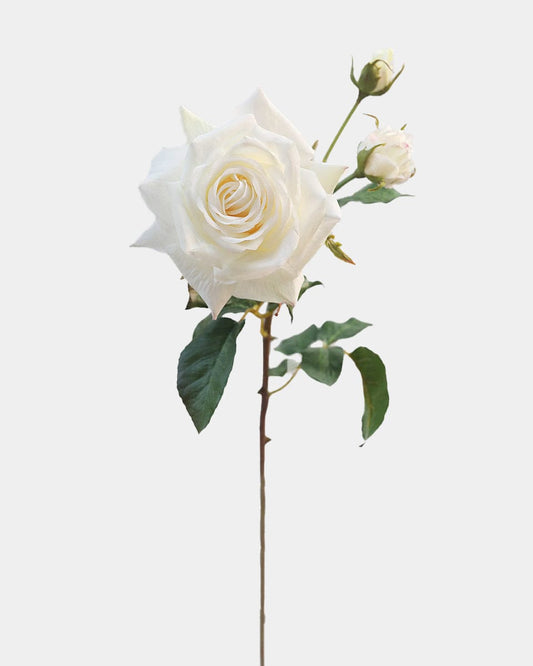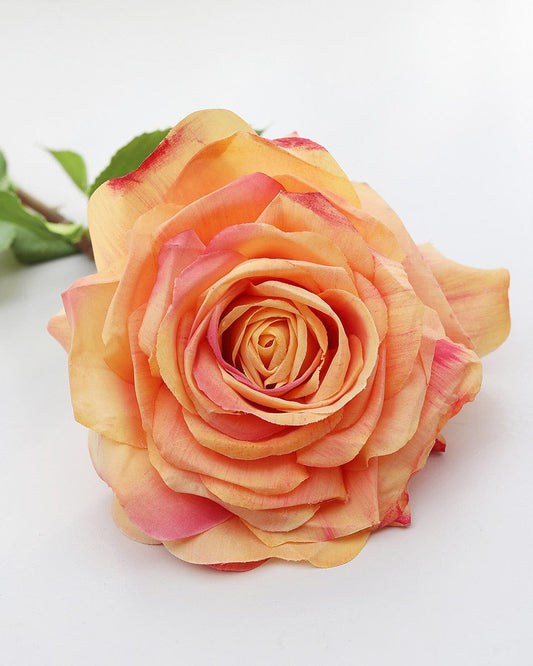Artificial Roses for Allergy Sufferers: Beautiful Blooms Without the Sneezing

Had to stop a student yesterday from throwing away what she called a “ruined” rose. The petals looked uneven, a little crumpled on one side. That’s not ruined—that’s character. And honestly, it’s the same mindset I want allergy sufferers to borrow: perfection isn’t the goal, comfort is.
Here’s the messy truth I tell clients who sneeze their way through spring weddings and fall centerpieces: real roses aren’t the worst pollen producers, but bouquets pick up grass, ragweed, and outdoor dust like hitchhikers. Then there’s fragrance sensitivity—some folks react to scent, not pollen. I asked an allergist last May if rose pollen was the main villain; she laughed: “It’s usually everything around the flowers.” So if you love roses but hate the fallout, our hypoallergenic artificial roses aren’t a compromise. They’re a strategy.
Key Takeaways
- Artificial roses remove pollen and fragrance variables, which helps many allergy sufferers breathe easier.
- Dust management is the real issue—clean weekly, avoid airflow, side‑light where possible.
- Light changes how color reads and how dust shows; test under your actual bulbs.
- Pet households benefit from faux stems: no pesticides, no sap, fewer chew risks when you trim/wrap wires.
Why Faux Roses Help More Than You Think
On the “Is this safe for my pets?” front—good question, because I get DMs about cats nibbling everything. Real rose petals are generally non-toxic to dogs and cats, but thorns, fertilizers, and floral preservatives are a whole other story. Faux roses skip all of that. No sap, no pesticide residue, no surprise bouquet add‑ins. Trim wire stems, cap any sharp ends, and keep arrangements out of reach if your pet thinks everything is a salad bar.
If you’re already thinking “But they look fake,” I hear you. Cheap ones do. The giveaway is always that plasticky shine and stiff angles. Fixable. Start with decent stems, then bend, space, and side‑light. It’s amazing how quickly “fake” turns into “huh, those look good.”
I was testing petal spacing for a low coffee‑table arrangement and grabbed the Mauve English Rose because muted tones are kinder in evening light. The head size sits nicely in threes without crowding, which means less dander‑catching overlap.


Mauve English Rose 23"
Soft mauve reads calm at night. I could spread three stems and it didn’t turn into one dense dust magnet, which is half the battle for sneezy friends.
If you’re shopping around and want a simple place to start, our collection of artificial roses is the easiest entry. Just sort it by best sellers and call it a day. And if you want the blink‑and‑believe look, take a look at our prestige roses collection, promise you won't be disappointed.
Dust, Airflow, and Light: The Trifecta
Dust is the sneaky culprit in most artificial arrangements. Not glamorous, but it’s what gets noses twitching. I keep a small, soft brush and a microfiber cloth handy, and I do a lazy five‑minute refresh weekly. Not perfect—good enough. Placement matters more than people think: avoid vents, fans, and direct HVAC lines. Dust in daylight when you can actually see what you’re doing.
If your nose is reactive, skip scented plugins near displays. Heat lifts dust from petals and wiring. Place arrangements two feet away from vents and use a handheld air blower on low once a week. Quick, quiet, surprisingly effective.
Let’s hit the allergy basics quickly, because people love absolutes. There aren’t any. Pollen counts spike with season and region—spring trees, late‑summer ragweed, different beasts. An allergist I work with repeats this a lot: control your environment first. Clean surfaces, low‑fragrance cleaners, and for flowers, low‑dust shapes. Roses are tidy pollen producers compared to lilies with pollen bombs, but a mixed bouquet? Lottery odds. Going faux just removes the guessing.
I use a Real Touch Pink Rose when I need to explain petal texture to skeptics. I pinch the edge, roll it lightly, and watch their face shift from doubtful to “oh.” The tactile piece convinces them more than any photo.


Real Touch Pink Rose 21.5"
I use this one to show skeptics the soft petal feel. The edge has a slight roll, which reads “real” without being precious.
And yes, artificial roses play nicely with air purifiers. Place the purifier’s intake across the room, not right beside the flowers, so you’re not stirring micro‑dust off the petals every hour. Light vacuuming around the base helps. Boring, effective.
Color and the “Real” Test
Color is where people push back the most. They want bright. Allergies don’t care about color (obviously), but bright petals show lint differently. The golden family is funny—I can’t tell if it skews lemon or gold… wait, I meant the warmth shifts depending on your bulbs. Warm LEDs make yellow feel richer; cool daylight makes it sharper. Side‑light always helps depth.
I pulled a Yellow English Rose to stress‑test this. Set it under a 3000K lamp, then a 5000K window. Under warm light it felt buttery; under cool light it edged toward citrus. Helpful if your room lighting changes.


Yellow English Rose 22"
Under warm light it feels buttery; under cool daylight it leans citrus. Nice if your room lighting swings morning to night.
If you love a crisp white that plays well with most rooms and phone cameras (white balance can be rude), I’ll grab a Real Touch White Rose and test it near a window. The soft edge tint keeps it from looking flat against pale walls, which means you don’t need extra greenery just to fake depth.


Real Touch White Rose 21.5"
Soft cream reads less stark by a sunny window. I didn’t need filler; two stems and a clean vase looked done.
Do a 10‑second petal shake outdoors before first styling. Packaging dust rides in from shipping. A quick shake plus a microfiber wipe removes the fine film that makes people think “itchy” even when pollen isn’t involved.
Pets, Purifiers, and Maintenance That Actually Keeps Noses Calm
Bedrooms are tricky if your HVAC vents aim low. Living rooms with softer, cross‑room airflow behave better. Dining tables are fine unless you run a ceiling fan at mealtime—that just turns petals into tiny shelves for dust. And yes, fragrance. I used to mist arrangements with diluted rose water. Then an allergist friend said half her patients react to fragrance molecules, not pollen. So now I skip scent entirely during peak season. Controversial opinion: fresh bouquets in April are an expensive gamble if you sneeze.
Two cleaning notes that matter more than any styling hack: a slightly damp microfiber cloth beats canned air for close‑up dust, and a soft makeup brush gets between petal ruffles without scraping. If you must wash, tepid water and a drop of mild soap, then air dry—no hair dryers.
If you made it this far, you already know the point: you can have the rose look you love and keep your nose calm. Control dust, skip scent, choose shapes with breathing room, and don’t overthink it. Start with a couple stems, bend, step back, tweak. Good enough beats perfect, every time.
Frequently Asked Questions
Are roses good for people with allergies?
Fresh roses are actually among the better choices for allergy sufferers since they're not heavy pollen producers. However, artificial roses eliminate all variables - no pollen, no fragrance sensitivity, and no outdoor allergens that hitchhike on fresh bouquets.
Will artificial roses trigger my allergies?
They don’t produce pollen or natural fragrance, so many people feel better with faux stems. The common trigger is dust. Keep them clean, place them away from vents, and consider an air purifier in the room—not right next to the flowers.
Are faux roses safe around pets?
Generally yes, because there’s no sap or pesticide residue. Trim exposed wire ends, avoid loose silk bits for chewers, and keep arrangements out of reach if your pet treats everything like salad. Real roses are usually non‑toxic, but thorns and additives are the problem.
How do I make artificial roses look real?
Bend stems for a natural tilt, vary heights, and leave air between blooms. Use matte greenery, avoid glossy leaves, and keep dust off the upper petal curves. Side‑light helps; direct overhead lighting flattens everything.










